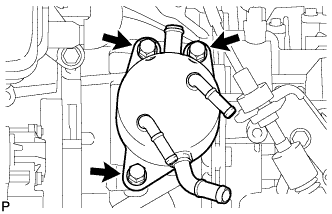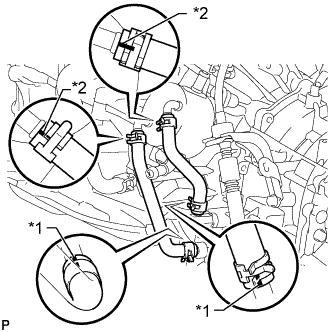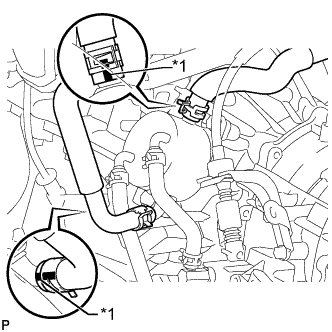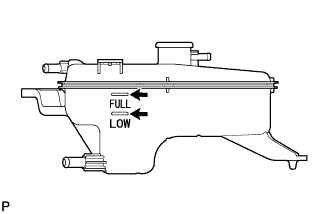Oil Cooler -- Installation |
| 1. INSTALL OIL COOLER |
 |
Install the oil cooler to the continuously variable transaxle assembly with the 3 bolts.
- Torque:
- 12 N*m{117 kgf*cm, 8 ft.*lbf}
| 2. INSTALL NO. 1 OIL COOLER INLET HOSE AND NO. 1 OIL COOLER OUTLET HOSE |
 |
Connect the 2 oil cooler hoses to the oil cooler and transaxle to install them.
- NOTICE:
- Make sure the pinching portion of each clip is facing the directions shown in the illustration and the paint marks are aligned as shown in the illustration.
Text in Illustration *1 White Paint Mark *2 Yellow Paint Mark
| 3. CONNECT WATER BY-PASS HOSE |
 |
Connect the 2 water by-pass hoses to the oil cooler.
- NOTICE:
- Make sure the pinching portion of each clip is facing the directions shown in the illustration and the paint marks are aligned as shown in the illustration.
Text in Illustration *1 Yellow Paint Mark
| 4. ADD ENGINE COOLANT |
Tighten the radiator drain cock plug by hand.
Add TOYOTA Super Long Life Coolant (SLLC) to the radiator reservoir filler opening until it is filled to the B line at the base of the reservoir filler neck.
- HINT:
- The B line is the lower edge of the inner wall of the filler neck.
- Standard capacity:
Item Specified Condition for Manual Transaxle 5.8 liters (6.1 US qts, 5.1 Imp. qts) for CVT 6.0 liters (6.3 US qts, 5.3 Imp. qts)
- HINT:
- TOYOTA vehicles are filled with TOYOTA SLLC at the factory. In order to avoid damage to the engine cooling system and other technical problems, only use TOYOTA SLLC or similar high quality ethylene glycol based non-silicate, non-amine, non-nitrite, non-borate coolant with long-life hybrid organic acid technology (coolant with long-life hybrid organic acid technology is a combination of low phosphates and organic acids).
- NOTICE:
- Never use water as a substitute for engine coolant.
 |
Press the No. 1 and No. 2 radiator hoses several times by hand, and then check the level of the coolant. If the coolant level drops below the B line, add TOYOTA SLLC to the B line.
Install the radiator reservoir cap.
Start the engine and warm it up until the cooling fan operates.
Set the air conditioning as follows while warming up the engine.
Measurement condition Item Condition Manual Air Conditioning System Fan speed: Any setting except off
Temperature: Toward WARM
Air conditioning switch: OffAutomatic Air Conditioning System Temperature: Toward MAX (HOT)
Air conditioning switch: OffMaintain the engine speed at 2000 to 2500 rpm and warm up the engine until the cooling fan operates.
- NOTICE:
- Make sure that the radiator reservoir still has some coolant in it.
- Pay attention to the needle of the coolant temperature meter. Make sure that the needle does not show an abnormally high temperature.
- If there is not enough coolant, the engine may burn out or overheat.
- After starting the engine, if the radiator reservoir does not have any coolant, perform the following: 1) stop the engine, 2) wait until the coolant has cooled down, and 3) add coolant until the coolant is filled to the B line.
- Run the engine at 2000 rpm until the coolant level has stabilized.
Press the No. 1 and No. 2 radiator hoses several times by hand to bleed air.
- CAUTION:
- When pressing the radiator hoses:
- Wear protective gloves.
- Be careful as the radiator hoses are hot.
- Keep your hands away from the radiator fan.
Stop the engine and wait until the coolant cools down to ambient temperature.
Check that the coolant level is between the FULL and LOW lines. If the coolant level is below the LOW line, repeat all of the procedures above.
If the coolant level is above the FULL line, drain coolant so that the coolant level is between the FULL and LOW lines.
 |
| 5. ADD CONTINUOUSLY VARIABLE TRANSAXLE FLUID |
Add continuously variable transaxle fluid (RAV4_ACA30 RM0000013BU03VX.html).
| 6. INSPECT FOR COOLANT LEAK |
Remove the radiator reservoir cap.
- CAUTION:
- To avoid the danger of being burned, do not remove the radiator reservoir cap while the engine and radiator are still hot. Thermal expansion will cause hot engine coolant and steam to blow out from the radiator reservoir.
Fill the radiator and reservoir with coolant, and then attach a radiator cap tester.
 |
Warm up the engine.
Pump the radiator cap tester to 118 kPa (1.2 kgf/cm2, 17.1 psi), and then check that the pressure does not drop.
If the pressure drops, check the hoses, radiator and water pump for leakage.
If there are no signs of external coolant leaks, check the heater core, cylinder block and head.
Reinstall the radiator reservoir cap.
| 7. INSTALL NO. 1 ENGINE UNDER COVER |
Install the under cover with the 6 screws and 10 clips.
 |